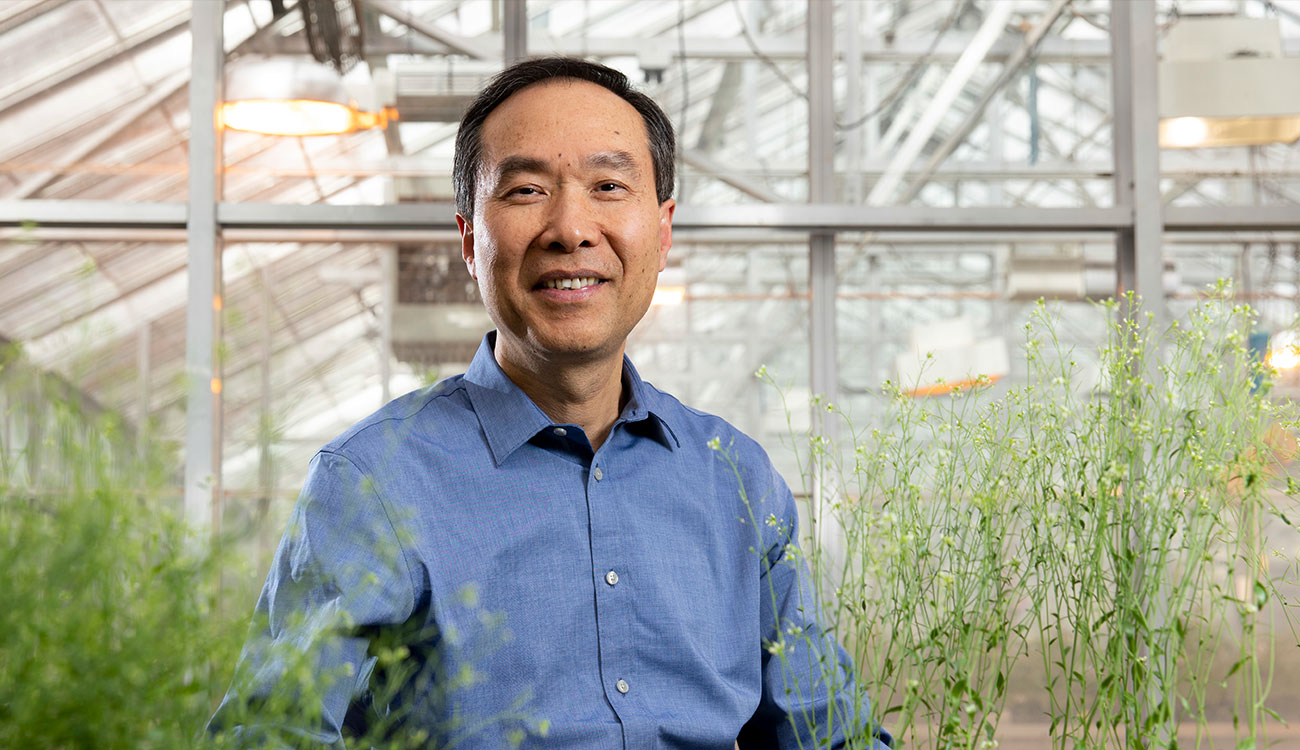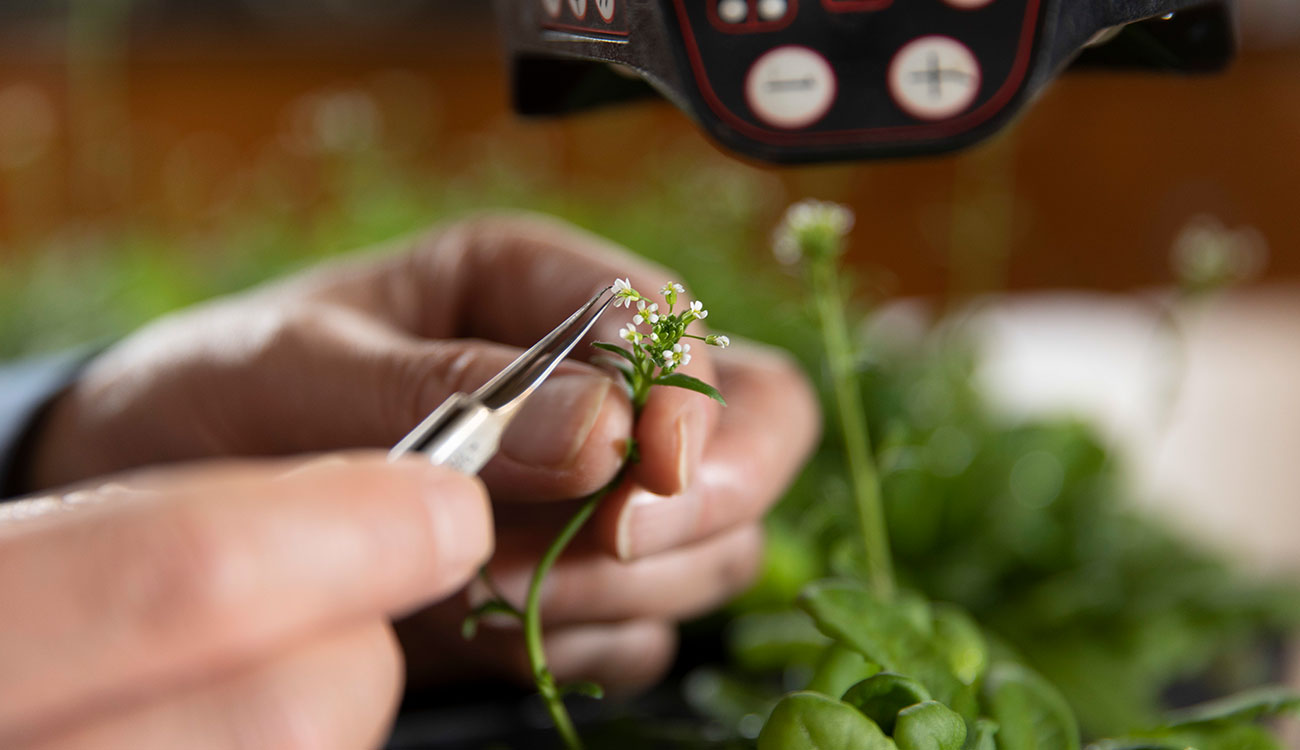



Upgrade your grazing: Science leads to better alfalfa
At its core, basic science is a never-ending quest to uncover how the universe works. It all starts with a single question that, through research, multiplies, evolves, and often finds something completely new.
“That’s the beauty of basic research,” said Zheng-Hua Ye. “You try to solve a puzzle, and it can lead to an unexpected discovery.”
In a quest for pure understanding of how plants make the secondary cell walls in wood and fibers, plant biologist Ye developed a trait in alfalfa that reduces the amount of a group of complex organic polymers known as lignin without reducing its strength. Lignin allows alfalfa to stand up vertically in the field, but it is not very digestible to cattle, a major consumer of the plant. The new trait rewires how the plant produces lignin, resulting in an increase in the yield of a farmer’s alfalfa crop and an improvement in the plant’s nutritional value: Less effort, more results.
Growing up in Zhejiang province in China, Ye went to college at Fudan University in Shanghai. His first love was medicine, but that soon changed.
“I wanted to be a doctor when I grew up because I watched how doctors could save people’s lives and how their work could directly benefit the public,” said Ye, professor of plant biology in the Franklin College of Arts and Sciences. “But agriculture is also so important to society, so I was attracted to the field of plant science.”
After college, he studied how to improve plant fibers for papermaking at the Institute of Botany, part of the Chinese Academy of Sciences in Beijing. After earning a master’s at the academy and a doctorate at Washington University in St. Louis, he joined UGA in 1996. His recent work has been a game-changer in the realms of plant biology and agriculture.
“I was fascinated by plants being able to lay down massive amounts of secondary cell walls in fibers and wood because they constitute the bulk of biomass produced by plants,” said Ye. “And I was curious about how this process is controlled at the molecular level.”
As the building blocks that physically support plants, secondary cell walls lend strength and stiffness to vascular plants, which need this protection to move water and nutrients throughout their structure. Ye knew that it’s the lignin, one of the major secondary wall components, that lends much of the rigidity and allows that wall to repel water. And it’s the lignin that makes plants like alfalfa less digestible by livestock.

“We had a strong interest in understanding how secondary cell walls are made,” said Ye. “For us, it was curiosity-driven, basic scientific research.”
So Ye and his team began researching the genes that control the biosynthesis of secondary cell walls. They wanted to understand what some of them did and what would happen if they decreased the level of their expression, a procedure known as downregulation. Using Zinnia elegans, an annual flowering plant in the daisy family, they had a hunch that they’d found their gene.
“We were just trying to prove that, if we could manipulate this gene, we could change both the amount and the composition of the lignin in the plant,” explained Ye.
With this new understanding, they decided to move from zinnia to tobacco plants and poplar trees to test the concept. They found that not only could they rewire lignin in the transgenic plants, but the process changed their entire understanding of how lignin is synthesized. This discovery transformed their investigation from a scientific inquiry to one with commercial potential.
This lignin rewiring trait is now commercially available to farmers as HarvXtra® Alfalfa and is the most advanced alfalfa trait on the market. It is also the first genetically engineered trait to maximize quality by reducing lignin content. The University of Georgia Research Foundation licensed the trait to the Oklahoma-based Noble Research Institute, which commercialized and sub-licensed it to Forage Genetics International to sell the product. This is the first time UGARF has received a share of a genetic “trait fee” associated with an improved plant cultivar.
Ye’s work earned him UGA’s Inventor of Year award in 2020. Clarivate Analytics has also named him a highly cited researcher for five consecutive years (2014-2018) for his research on secondary wall biosynthesis, putting him among the top 1% most cited in the field of plant and animal science.
With altered lignin, the alfalfa plant has a delayed aging process, is more digestible for cattle, and is of higher quality overall than other feeds. These traits not only allow farms to be more flexible in managing the time between harvests without losing forage quality, but they also increase yield by 20%, which means more profit. What’s more, feeding the cows alfalfa instead of corn provides the animals more protein, potassium and calcium.
“As scientists focusing on basic research, we weren’t trained to think about patenting, and I had no idea it would be worth filing for one,” explained Ye. “But I’ve been working on secondary cell wall formation my whole life, so it is gratifying to see my basic research leading to a product that benefits the public.”
In addition to being available in the U.S., HarvXtra® Alfalfa is also in the process of being commercialized in Canada, Mexico and Argentina.
Other knots Ye has been trying to unravel are finding the genetic switches that control how trees create their secondary cell walls and uncovering all of the genes involved in the biosynthesis of xylan, another major building block in these walls. The knowledge gained from these endeavors could lead to genetic tools capable of custom-designing secondary cell walls tailored to a variety of uses.
Yet perhaps the challenge with the most significant future impact may be his work that aims to make producing biofuels from the most plentiful raw material on earth feasible. That raw material is known as lignocellulosic biomass (think of it as the dry matter of plants). Turning this material into biofuels is difficult because secondary cell walls are incredibly resistant to efforts to break them down. Improving the ability to deconstruct these walls will be an enormous boost in making biofuels more abundant, cheaper and more available than other energy sources, such as fossil fuels.
“I’ve done basic research my whole life and have always said it has a potential impact on crop improvement with direct benefit to the public, but never dreamed of my discoveries seeing the light of day,” said Ye.
Now with the commercialization of the lignin rewiring trait, that potential has become real.


